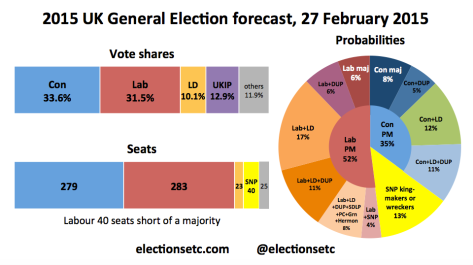No change in our polling average this week: it’s still Lab 33%, Con 32%, as it has been since the start of 2015.
Our model therefore still makes the Tories favourites to win the most votes (with a 67% chance), but Labour very slight favourites to win the most seats (with a 52% chance). Neither party is likely to win a majority, though: we give the Tories an 8% chance and Labour a 6% one, leaving an 87% chance of a hung parliament (up a touch from 86% last week).
So, if parliament does end up hung, who will govern? We’ve given that question more thought, listened to your input and others’, and changed our assumptions as to which alliances are most likely – as you can see from the graphic above.
We now assume that whichever party has the most MPs will do a deal with the DUP, if that’d yield a majority (either in coalition, or a confidence-and-supply agreement). If it wouldn’t, we then ask whether an alliance with the Lib Dems would, or failing that a three-party deal with both the Lib Dems and the DUP.
If Labour are the largest party but the Lib Dems and DUP aren’t enough to give them a majority, we then assume they’d call on the smaller left-wing parties (the SDLP, Plaid Cymru and the Greens), as well as Lady Hermon if necessary.
(Note that UKIP don’t appear, as there’s practically no chance of them winning more seats than the DUP.)
That leaves the SNP. What if neither party can get to 323 MPs without them? (Our model gives a 16.5% chance of this.)
First, there’s a 3.5% chance that Labour have the most seats and a Lab-SNP alliance would yield a majority (without the others). Under these circumstances, Ed Miliband might well be able to cut a deal with Nicola Sturgeon and Alex Salmond that would put him into Number 10. But it will still be difficult for the two parties to resolve their difference on Trident and the moral force that goes with Labour winning most seats will be tempered by having fewer votes than the Tories.
There’s a 13% chance the Tories are the largest party, but can’t reach a majority without at least SNP acquiescence. In that scenario, the SNP would essentially have four options (having ruled out actively supporting a Tory-led government): abstain, allowing a Tory PM to win a confidence motion with LD and DUP support; back a Labour+LD government; abstain on a confidence vote for a broader Left alliance; or vote against any deal. If the SNP choose the fourth option, neither Cameron nor Miliband (nor their successors, if they step down) would be able to win a confidence vote without the other’s party at least abstaining. Since a grand coalition appears to be the hardest deal of all and both major parties would have strong incentives to vote no confidence in the other and force the SNP to take responsibility for effectively backing or sacking and perhaps forcing another general election. We therefore call this the “SNP kingmakers or wreckers” scenario.
While this sounds like a powerful position for the SNP, the other parties might be so uncompromising that the situation might actually be very uncomfortable for them. The SNP probably don’t want to be seen as either allowing the Tories to continue in power, or supporting a “league of losers on the left” if there are not concessions on Trident, but equally forcing another general election is unlikely to make them more popular.
Acknowledgements: We particularly would like to thank Richard Coggins, Philip Cowley, John Curtice, Iain McLean, Petra Schleiter and Jon Tonge for their comments and advice on these assumptions and issues. We were able to incorporate some but not all of their suggestions. Defects are of course our responsibility. We will be writing a more thorough discussion in due course.
Date of forecast: 27 February 2015
Days till the election: 69
Inputted current average poll shares
Con: 32%
Lab: 33%
LD: 8%
UKIP: 14%
Others: 13%
Forecast GB Vote Shares (with 95% Prediction Intervals)
Con: 33.6% (29% – 38%)
Lab: 31.5% (27% – 36%)
LD: 10.1% (6% – 15%)
UKIP: 12.9% (9% – 17%)
Others: 11.9% (10% – 14%)
Forecast Scotland Vote Shares (with 95% Prediction Intervals)
SNP: 44% (40% – 48%)
Labour: 31% (27% – 35%)
Forecast GB Seats (with 95% Prediction Intervals)
Con: 279 (235 – 330)
Lab: 283 (235 – 325)
LD: 23 (13 – 36)
SNP: 40 (27 – 50)
PC: 3
UKIP: 3
Grn: 1
(May not sum to 632 due to rounding of sums of probabilities. Prediction intervals not yet available for UKIP, PC and Grn.)
Central forecast: Lab short of a majority by 40
(Criterion for majority now changed to 323 not 326, assuming Sinn Fein win 5 seats and do not take them.)
Probabilities of key outcomes
Con largest: 48%
Lab largest: 52%
Hung Parliament: 87%
… with Con largest: 40%
… with Lab largest: 47%
Probabilities of predicted government outcomes:
Con majority: 8%
Con+DUP: 5%
Con+LD: 12%
Con+LD+DUP: 11%
Con largest, SNP kingmakers or wreckers: 13%
Lab majority: 6%
Lab+DUP: 6%
Lab+LD: 17%
Lab+LD+DUP: 11%
Lab+LD+DUP+SDLP+PC+Grn+Hermon: 8%
Lab+SNP: 4%
(Probabilities may not sum due to rounding)


The Fixed Term Parliament Act is specific as to the wording of a no confidence motion To trigger a general election. The humble address on the Queen’s Speech would not count so a PM would have to resign but no election would follow unless a separate motion were carried.